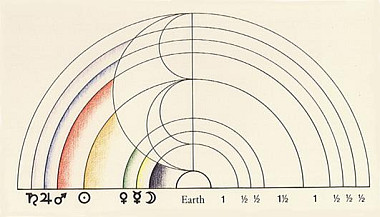The philosopher and mathematician Pythagoras is believed to be amongst the first known men to put together a system to organize color. In his system, colors and music were linked to the creation of the universe and spirituality.

A little over two centuries later, Aristotle is known to have put together a system that both organized color, and perhaps more importantly, experimented with mixing color. His system was in part the result of blending blue and yellow light cast over marble during the daytime. His organization is very interesting in that it reflects the hypothetical, fleeting colors of light cast during the day- moving from white light at noon, and eventually gaining tinges of other colors and more or less transitioning until the apparent literal black of night. Interestingly it appears to leave out orange. He also notes his belief that black and white are opposites and that colors appear visually different when juxtaposed over other colors. Aristotle also began to identify colors as being connected to alchemic elements such as fire- a belief that will persist in medicine and the arts on through the 18th century or so in some circles.

The main event however, came about in the early part of the seventeenth century. In 1611 Aron Sigfrid Forsius, a Finnish priest and astronomer, developed a cyclical chart that could make sense without the added component of tracking light during the course of a day. It could stand alone as each color transitions into the next with a greater degree of sense than previous charts. In Aristotle's, for example, violet jumps to green, then green jumps to blue. A near impossible feat under normal circumstances. Forsius' moves relatively smoothly. It seems to have a flow, and even includes a gray, which Forsius believed to reside in the middle of all else. While looking at his chart, you might also note that his system also includes complementary colors- in general placed across from one another . He also believed that black and white were more or less colors from which all others were derived.

One should also note the named colors on the chart. They're much more than your boring "red" and "blue," and can tell us a great deal about the world of the people of the late 16th, early 17th centuries. In truth, they were not too dissimilar to us. We have Crayola crayons with a plethora of such creative colors as jazzberry jam, macaroni and cheese, and outerspace, while Forsius' system offers us tree, wheat, and apple mold in addition to more conventional names. If you look through wills, inventories, and other primary sources from the Early Modern Era, you will find many more interesting color names similar to these. Many lean a little to the outrageous side with such choices as the charming pallid gray of Dead Spaniard, Puke a lovely brown, and the self-explanatory Whey and Gooseturd.. Dead Spaniard, if not a flattering color to wear, alludes to the appreciation of the English people for Spain's not-so-friendly imperialism, some of the others to just how shy Early Modern people really were about embracing reality. They also had colors that related directly to places such as Bristol Red and Lincoln Green.
I think we ordinarily associate much of history with peasants, dirt, and ultimately drab colors. Highlighting the profoundly excellent title of a profoundly horrible book (It's content is poorly researched and encourages misconceptions), A World Lit Only By Fire, summarizes and reinforce this sort of idea we have of our ancestors being universally primitive for several centuries. This is clearly not the case.
Works Consulted
Crone, Robert A.. A History of Color: The Evolution of Theories of Light and Color. 1st ed. New York: Springer, 1999. Print.
Gage, John. Color and Culture: Practice and Meaning from Antiquity to Abstraction (Color & Culture). Milwaukee: Bulfinch Pr, 1993. Print.
Mikhaila, Ninya. The Tudor Tailor: Reconstructing 16th-Century Dress. London: B.T. Batsford, 2006. Print.
Morris, Robert. Clothing of the Common Man 1580-1660. Bristol: Stuart Press, 2005. Print.
Images provided by...
"The History of Colour Systems." BibliOdyssey. Web. 19 Sept. 2010.
No comments:
Post a Comment